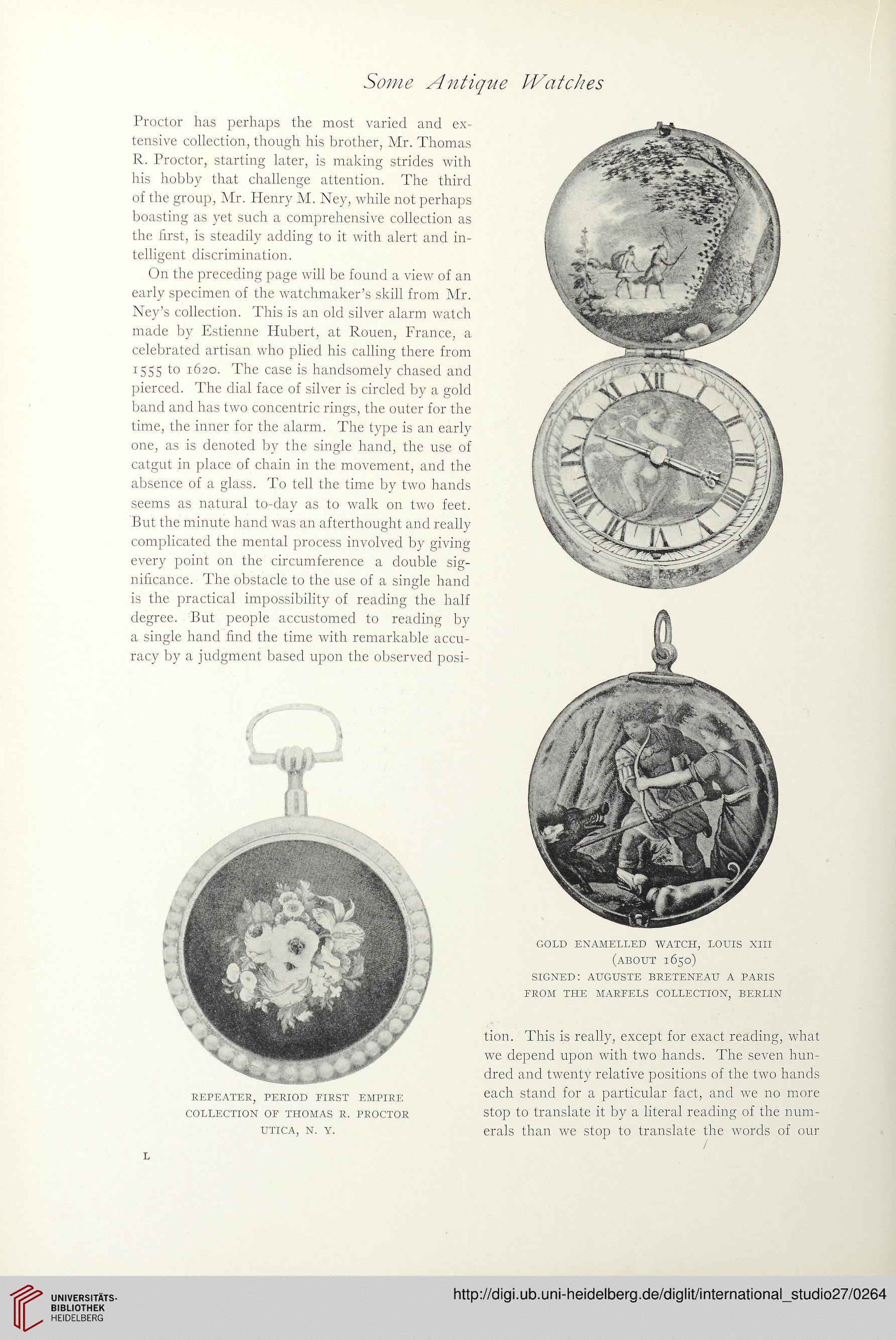Some Antique IVatches
Proctor has perhaps the most varied and ex-
tensive collection, though his brother, Mr. Thomas
R. Proctor, starting later, is making strides with
his hobby that challenge attention. The third
of the group, Mr. Henry M. Ney, while not perhaps
boasting as yet such a comprehensive collection as
the first, is steadily adding to it with alert and in-
telligent discrimination.
On the preceding page will be found a view of an
early specimen of the watchmaker’s skill from Mr.
Ney’s collection. This is an old silver alarm watch
made by Estienne Hubert, at Rouen, France, a
celebrated artisan who pliecl his calling there from
r555 to 1620. The case is handsomely chased and
pierced. The dial face of silver is circled by a gold
band and has two concentric rings, the outer for the
time, the inner for the alarm. The type is an early
one, as is denoted by the single hand, the use of
catgut in place of chain in the movement, and the
absence of a glass. To teil the time by two hands
seems as natural to-day as to walk on two feet.
But the minute hand was an afterthought and really
complicated the mental process involved by giving
every point on the circumference a double sig-
nificance. The obstacle to the use of a single hand
is the practical impossibility of reading the half
degree. But people accustomed to reading by
a single hand find the time with remarkable accu-
racy by a judgment basecl upon the observed posi-
REPEATER, PERIOD EIRST EMPIRE
COLLECTION OE THOMAS R. PROCTOR
UTICA, N. Y.
GOLD ENAMELLED WATCH, LOUIS XIII
(about 1650)
SIGNED: AUGUSTE BRETENEAU A PARIS
FROM THE MAREELS COLLECTION, BERLIN
tion. This is really, except for exact reading, what
we depend upon with two hands. The seven hun-
dred and twenty relative positions of the two hands
each stand for a particular fact, and we 110 more
stop to translate it by a literal reading of the num-
erals than we stop to translate the words of our
L
Proctor has perhaps the most varied and ex-
tensive collection, though his brother, Mr. Thomas
R. Proctor, starting later, is making strides with
his hobby that challenge attention. The third
of the group, Mr. Henry M. Ney, while not perhaps
boasting as yet such a comprehensive collection as
the first, is steadily adding to it with alert and in-
telligent discrimination.
On the preceding page will be found a view of an
early specimen of the watchmaker’s skill from Mr.
Ney’s collection. This is an old silver alarm watch
made by Estienne Hubert, at Rouen, France, a
celebrated artisan who pliecl his calling there from
r555 to 1620. The case is handsomely chased and
pierced. The dial face of silver is circled by a gold
band and has two concentric rings, the outer for the
time, the inner for the alarm. The type is an early
one, as is denoted by the single hand, the use of
catgut in place of chain in the movement, and the
absence of a glass. To teil the time by two hands
seems as natural to-day as to walk on two feet.
But the minute hand was an afterthought and really
complicated the mental process involved by giving
every point on the circumference a double sig-
nificance. The obstacle to the use of a single hand
is the practical impossibility of reading the half
degree. But people accustomed to reading by
a single hand find the time with remarkable accu-
racy by a judgment basecl upon the observed posi-
REPEATER, PERIOD EIRST EMPIRE
COLLECTION OE THOMAS R. PROCTOR
UTICA, N. Y.
GOLD ENAMELLED WATCH, LOUIS XIII
(about 1650)
SIGNED: AUGUSTE BRETENEAU A PARIS
FROM THE MAREELS COLLECTION, BERLIN
tion. This is really, except for exact reading, what
we depend upon with two hands. The seven hun-
dred and twenty relative positions of the two hands
each stand for a particular fact, and we 110 more
stop to translate it by a literal reading of the num-
erals than we stop to translate the words of our
L





